Learning how to draw a face is a skill that some artists specialize in, but it’s one that all artists should eventually learn. The skills involved in how to draw a face can translate to many other aspects of an artist’s experience, and those who become talented at drawing faces can even make a career of it.
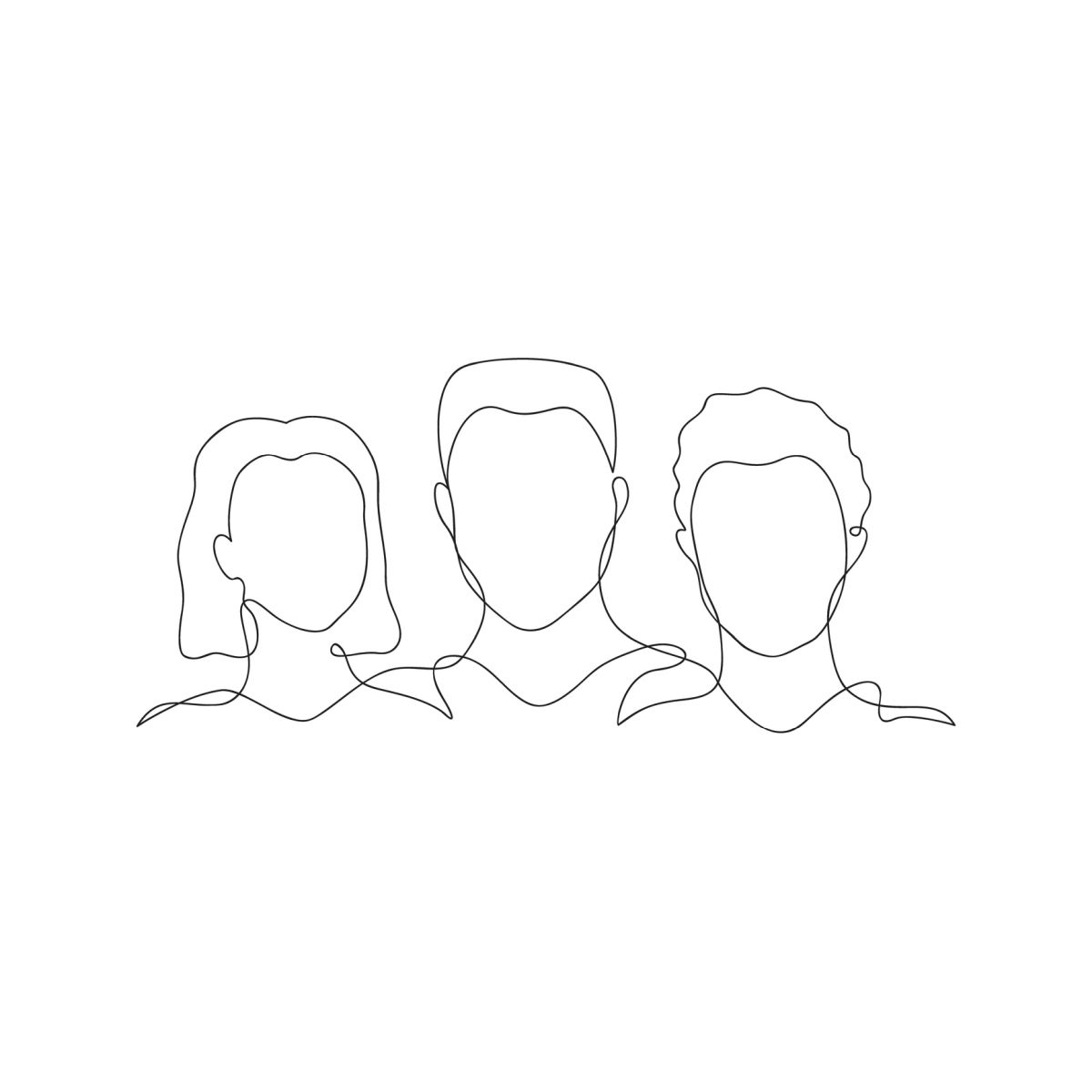
Keep reading to learn more tips on how to realistically draw a face and what you need to pull it off.
Tips for How to Draw a Face
Before we study specific tutorials for drawing faces, it’s smart to look at some general tips for drawing faces that can help you as you progress in the skill.
These are some hints for getting off on the right foot when it comes to learning how to draw a face:
- Start light. One of the smartest tips you can learn for drawing faces is to keep your pencil strokes as light as possible when you begin.
- Add guidelines. Keeping the proportions of the face even can be difficult even for experienced artists, but drawing in proportional guidelines can help you find the face’s underlying anatomical structure and keep it realistic.
- Try shading instead of lines to draw the nose. One of the biggest mistakes beginner artists make when they learn to draw a face is drawing the lines of the nose too hard and defined. Shading is a better way to imply the shape of the nose without making it look cartoonish.
- Isolate different facial features to learn. Drawing individual facial features can make you better at drawing faces overall since small mistakes in any of these features can ruin the whole of an entire drawing. Practice drawing dozens of noses, mouths, eyes, and ears to learn their shapes.
- Leave highlights for a three-dimensional look. Shading is only one part of making a face drawing look realistic. You should also leave brightened places to show where light is hitting the face.
- Match your strokes to hair length and texture. Hair is one of the trickier parts of a face drawing to master, but a good way to start is to pay attention to the direction that hair is falling and use short strokes for short hair, and long continuous strokes for long hair. Also note that no person’s hair falls perfectly, so look for stray hairs to make the drawing realistic.
Supplies You Need for How to Draw a Face
Before you learn how to draw a face, you’ll need to have the proper supplies. These are some of the supplies you’ll need when start drawing faces:
- Paper
- Pencil and pen
- Eraser
- Flat surface to draw on
- Reference photo
- Colors (can be watercolor or colored pencils)
- Face-drawing tutorial
When Would You Draw a Face
Faces are one of the most popular art subjects in the world, and you can find thousands upon thousands of portraits in both historical and modern artworks.
Whether you just want to learn to draw faces casually for your sketchbook or you’re intent on becoming a professional portrait artist, it’s one of the most useful drawing subjects to study.
Portraits make great gifts and can be used to commemorate important people in your life. Because they are so complicated, drawing faces is also one of the most effective forms of general drawing practice.
Mastering facial drawings can teach you a lot about proper shading, anatomical structure, perspective proportions, and other skills that will translate to other types of drawing.
Best Uses for Face Drawing
Want to draw faces but don’t know what to do with them? Here are just a few things you can do once you learn to draw a face:
- Draw realistic or stylized people in comics, book illustrations, and graphic novels
- Illustrate a hand-crafted holiday card for friends and family
- Frame portraits as fine art
- Draw quick portraits as gifts
- Create tattoos or stickers
- Decorate your notebook covers
Common Mistakes When Drawing Faces
Learning to draw a face is one of the harder drawing subjects you can take on as an artist, and many people make the same common mistakes when they’re starting out.
Here are some of the beginner mistakes people make when they draw a face:
- Disproportionate facial features. Having eyes that are too large or a mouth that is too wide can make the face look unrealistic. Studying the anatomical proportions of the face is the solution to lacking proportion in your face drawings.
- Uneven facial features. Even though the face is subtly asymmetrical, it appears symmetrical to the casual observer. Making facial features that are two different sizes from one side of the face to the other can draw the eye of the viewer in a negative way.
- Too much erasing. Too much erasing on your face drawing can make the sketch look muddied and damage the texture of the paper. To avoid this, keep pencil strokes light throughout the sketch. You can always darken the final lines with a pen afterward.
- Misplacing the eyes or ears. Placing the eyes or ears on the face too high or too low can throw off all other proportions on the drawing. Ensure the proper placement of facial features in a portrait by using guidelines.
- Not emphasizing detail and structure. Leaving out shading and the smaller details of the face can reduce the realism of the drawing and make it look flat. Add plenty of shading and texture to make the drawing look more refined and completed.
Easy Steps How to Draw a Face
- Start with two circles. These circles represent the skull and the jaw. The place where the two circles intersect is where the eye level of the face should be. Drawing a horizontal line at this point followed by a vertical line down the center of the two circles. These will be your starting guidelines.
- Draw facial guidelines. Drawing lines to cut the face into anatomically correct proportions can help you keep your ears and eyes aligned. It can also help keep you from making your eyes, nose, or mouth the wrong size or off-center.
- Draw the eyes and nose. The eyes and nose are the most distinguishing features of the face. The eyes convey the emotions of the portrait, while each person’s nose is distinctive to their individual face. Both of these features together help convey the portrait’s personality.
- Draw the eyebrows. Pay attention to the direction of the hairs in the eyebrow rather than trying to draw it as an outline or a solid piece of shading. This will help the eyebrows look more realistic.
- Draw the lips. It’s important to practice drawing many different kinds of lip shapes and expressions. Try drawing mouths that are in the middle of actions such as speaking, chewing, or grimacing.
- Draw the ears. A big mistake many people make when drawing ears on a face is setting the ears out too far out to the side. But if you actually look at a person’s head, you’ll notice that the ears are mostly set flat along the sides of the skull if the person is being sketched from the front.
- Draw the hair. Pay attention to the direction of the lighting that is hitting the face to see where the highlights and shadows would be. Another thing to look at is the direction that the hair is falling or growing to determine the direction of your strokes and linework.
How to Draw a Face: 15 EASY Drawing Projects
1. How to Draw Realistic Lips
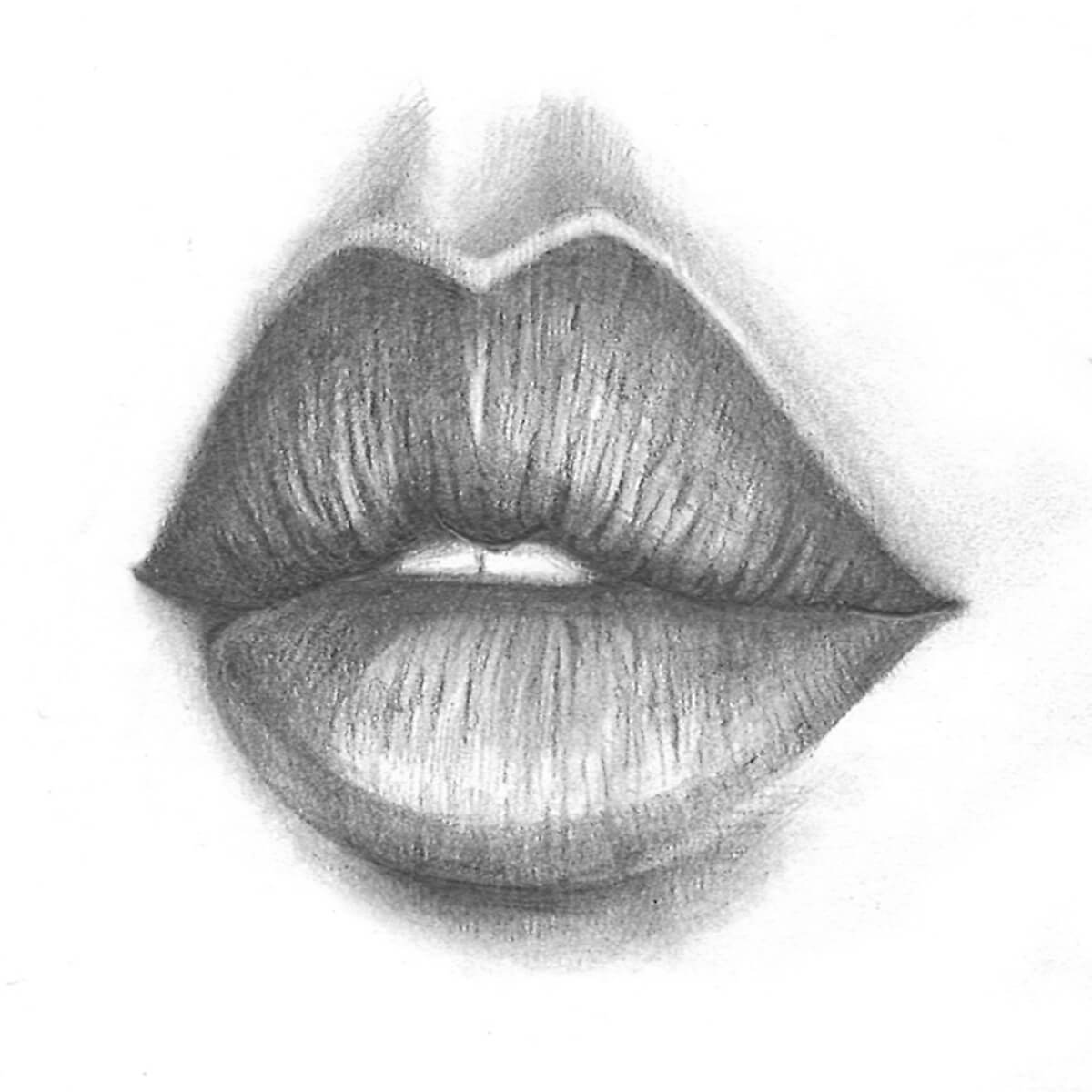
Getting the lips right in a face drawing is crucial to capturing the subject’s true facial expression. This tutorial at Arteza will show you three different ways to draw the lips: in a three-fourths perspective, with the teeth visible, and in a frontal view.
2. Draw a Beautiful Female Face

Female faces are one of the most common and popular art subjects in the world. This basic tutorial will teach you how to draw a female face while giving you a good walkthrough in proportional guidelines.
3. How to Draw Faces
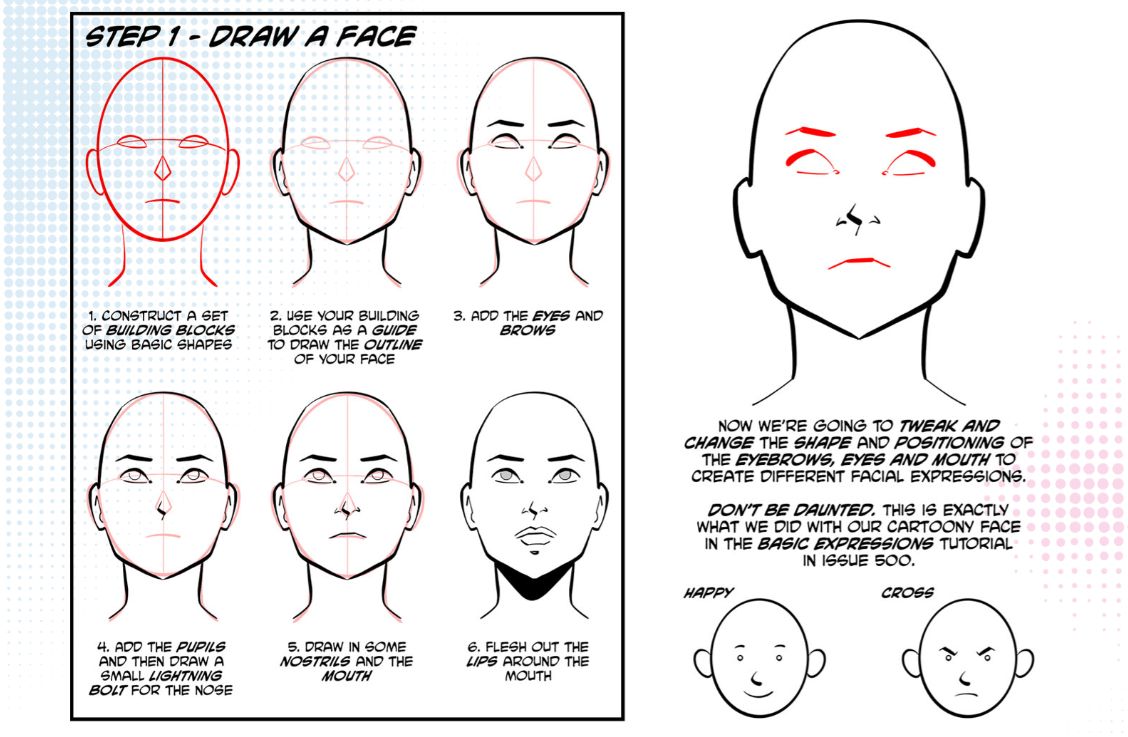
This tutorial from Phoenix Company gives you an overview of how to draw a face from several different angles. This can be useful if you plan on drawing people speaking together in the conversation since you’ll need to capture them from multiple perspectives.
4. How to Draw an Anime Face
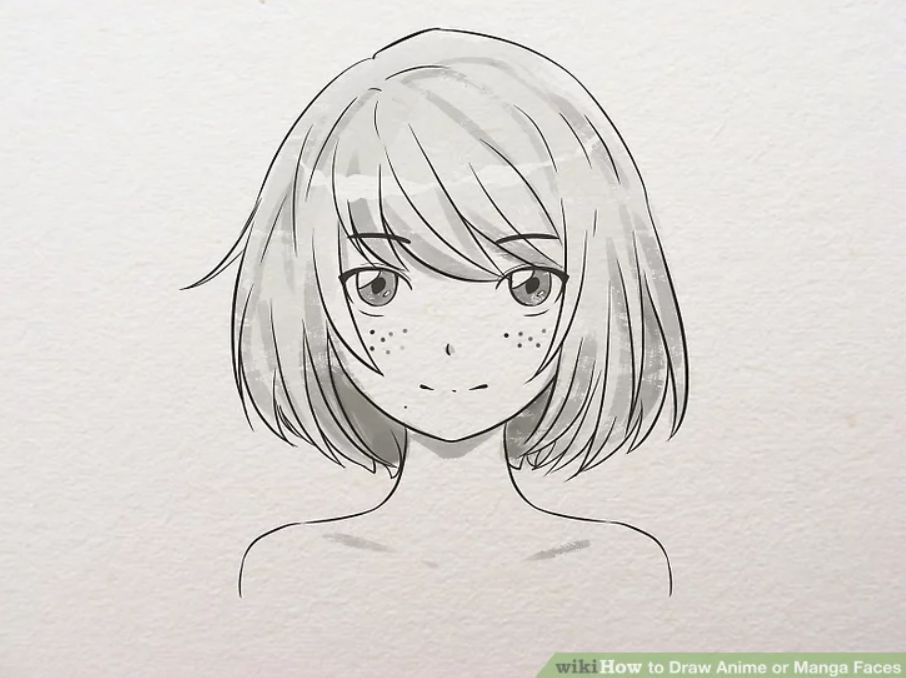
One reason many people want to learn how to draw faces is so that they can illustrate their own comic books, manga, or graphic novels.
This tutorial from Wikihow will teach you how to draw a basic anime face that can help you learn how to draw other stylized portraits too. Anime is a definitive style in which facial features are often exaggerated.
5. How to Draw a Face in 8 Steps
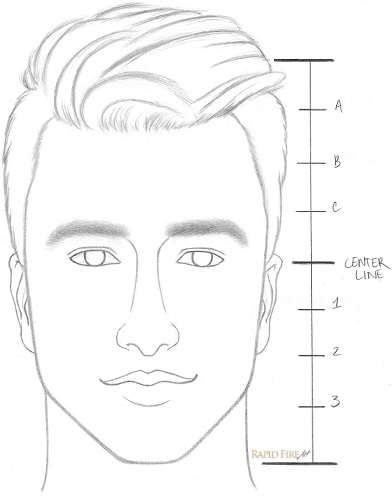
This tutorial at Rapid Fire Art is a useful resource for learning how to use a ruler to draw faces. It also helps you learn how to identify proportional errors in face drawings that can keep your drawings from looking realistic.
6. A Beginner’s Guide to Drawing Facial Features
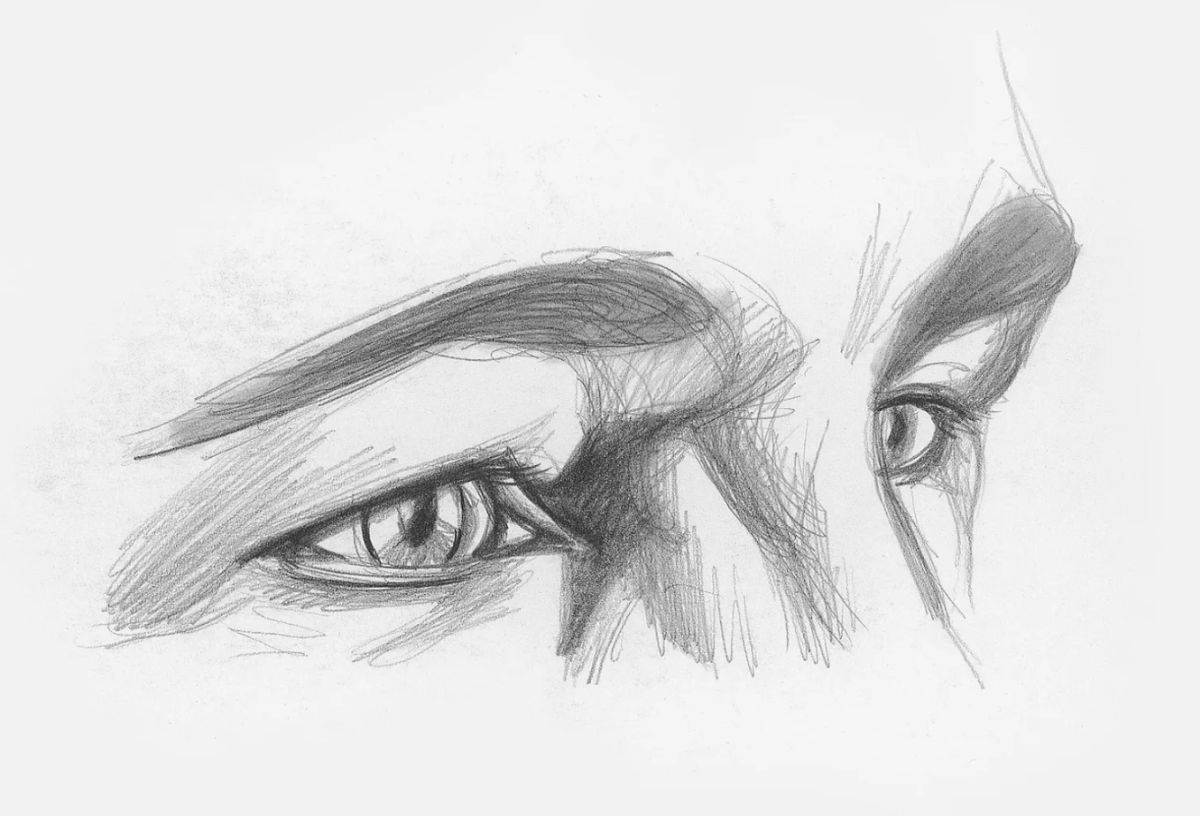
When it comes to learning how to draw a face, it’s often better to focus on individual facial features rather than the big picture. This guide at Artists Network shows you a few different ways to practice drawing each feature of the face.
7. How to Draw Cartoon Faces
`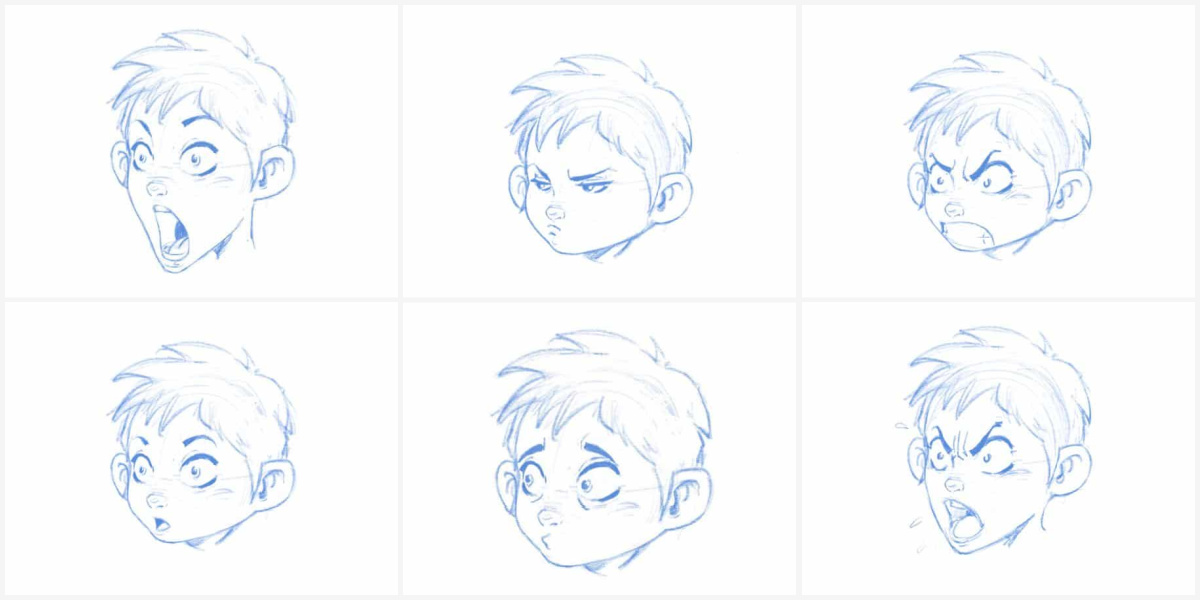
Sometimes when you’re learning how to draw a face, you aren’t interested in realism. Cartoon faces often feature the same basic parts of a realistic face, but with more exaggerated proportions and expressions.
Learn how to draw cartoon faces here at Improve Your Drawings.
8. Draw an Angry Face
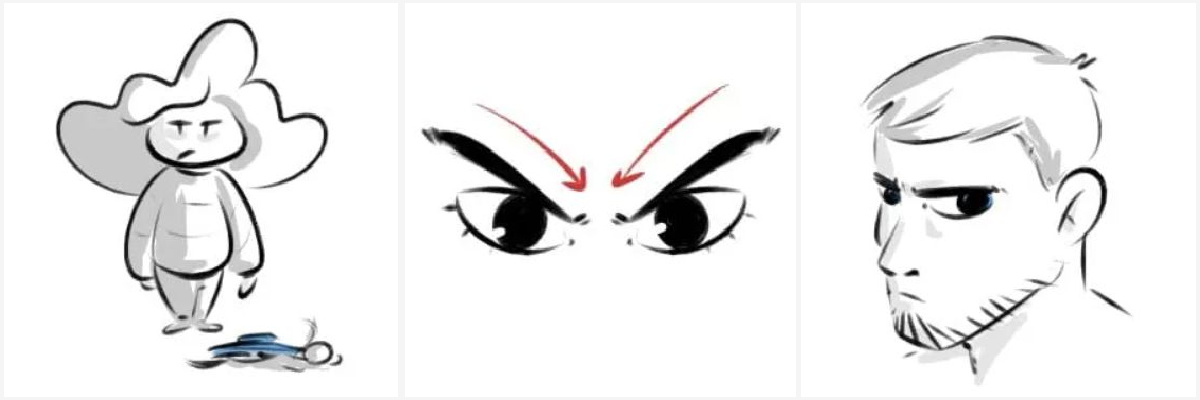
One of the challenges of drawing faces is capturing a lively expression. This guide from Don Corgi is useful for learning how to manipulate the features of the face to express anger.
A good hint to keep in mind is that a lot of facial anger is conveyed through the eyebrows and the set of the mouth.
9. Mastering Facial Expressions
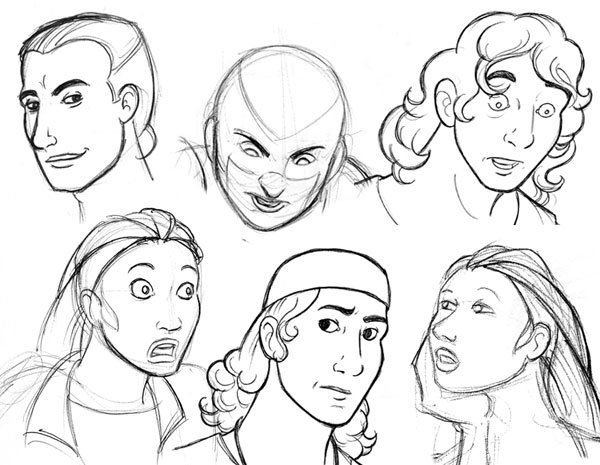
Without the artist properly conveying facial expressions, a drawing of a face can look flat and unnatural. This guide at Envato Tuts+ breaks down how facial expressions affect the look of each specific facial feature.
10. How to Draw a Female Face From the Side

Drawing a face in profile is much different than drawing a face from the front, but it can still be done well if you remember the anatomical structure of the face as your drawing’s perspective changes.
This guide at Drawing How to Draw will teach you how to draw a woman’s face from the side.
11. How to Draw Different Eye Shapes
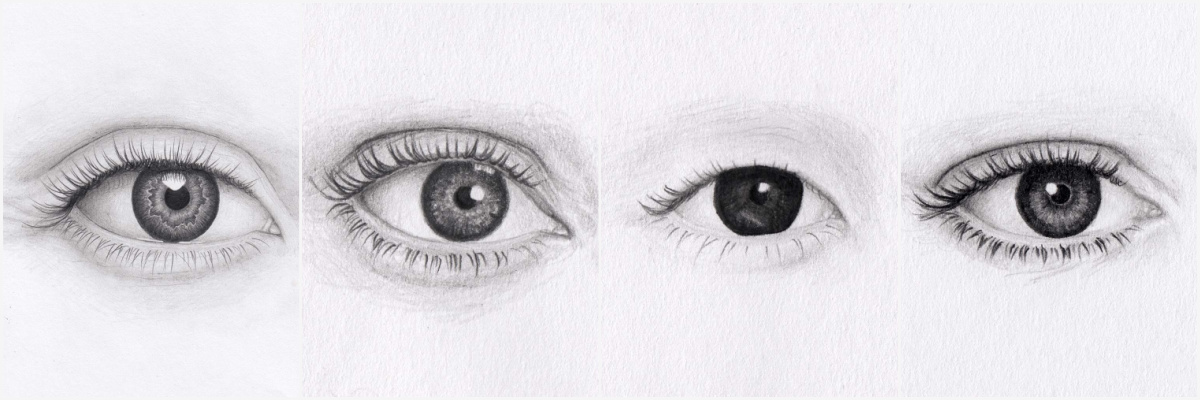
Eyes are one of the hardest features of the face to get right when drawing it. The eyes can come in many sizes, shapes, and colors.
This tutorial at How to Art teaches you how to draw several different eye shapes and also gives a useful overview of the anatomy of the eye.
12. How to Draw a 3/4 View Face
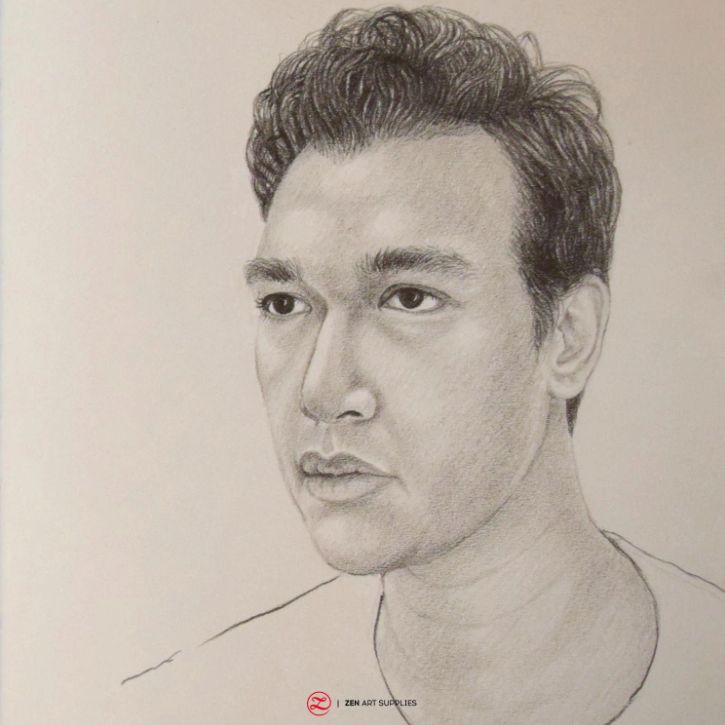
A 3/4 view is one of the more challenging perspectives to draw when it comes to drawing faces, but it’s also one of the most popular perspectives for drawing formal portraits.
This guide at Zen Art Supplies walks you through how to set up your guidelines and proportions for a 3/4 view portrait.
13. How to Draw a Realistic Nose
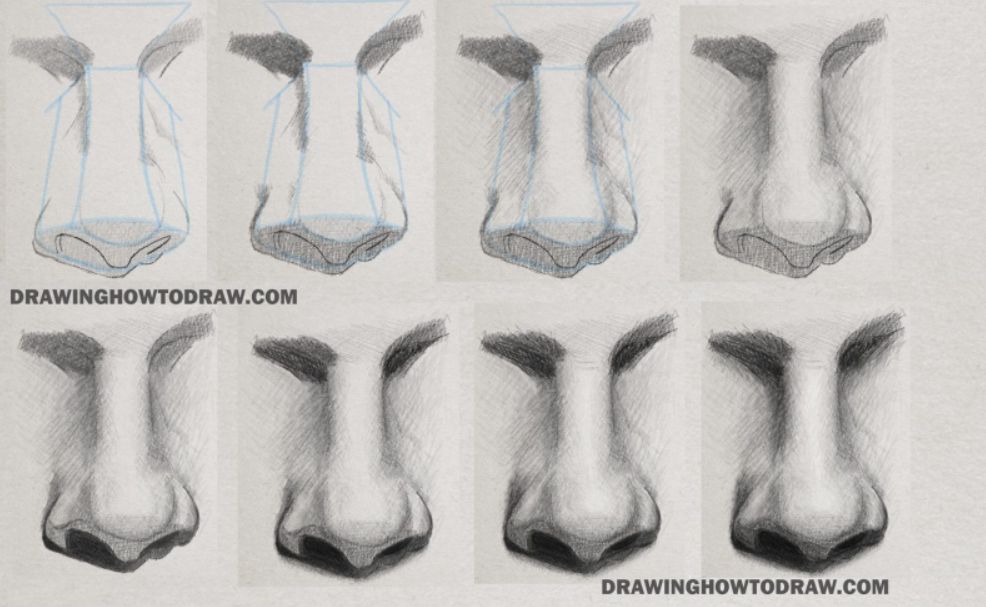
Noses are made up of complicated curves and shapes that can make drawing them difficult, and since they’re in the center of the face they can make or break the whole drawing.
Check out this tutorial at Drawing How to Draw for a walkthrough on learning how to draw a realistic nose.
14. How to Draw Different Hair Textures
`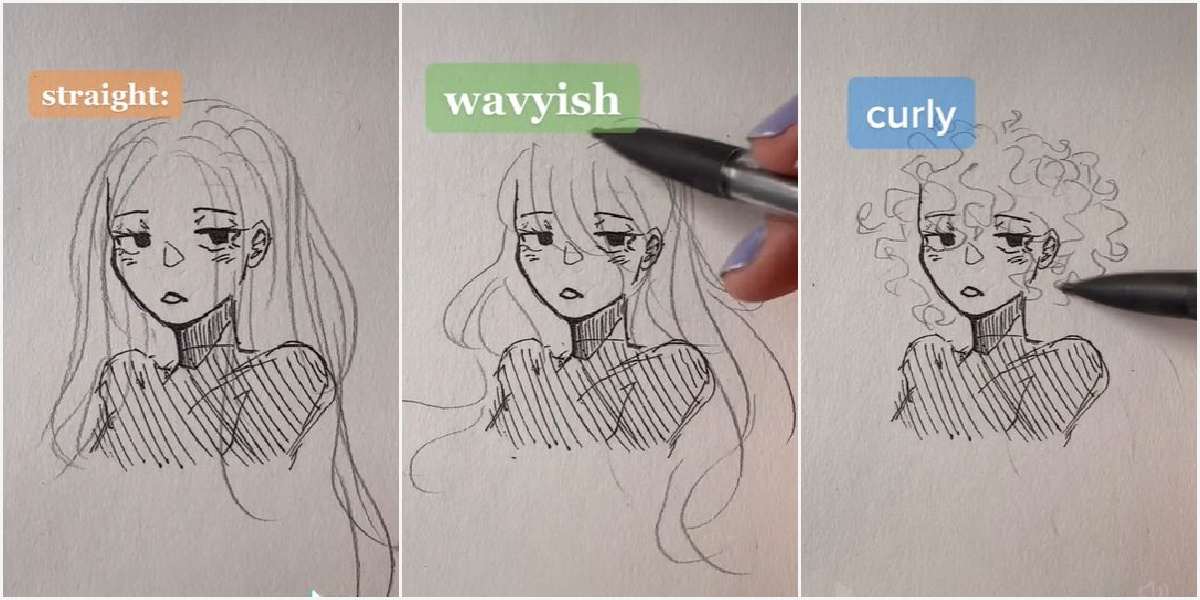
Drawing realistic hair can be hard if you try to draw what you think the hair looks like instead of what you actually see. This TikTok tutorial shows you how you can use different pencil strokes to show multiple types of hair textures.
15. How to Draw a Face in Just Ten Minutes
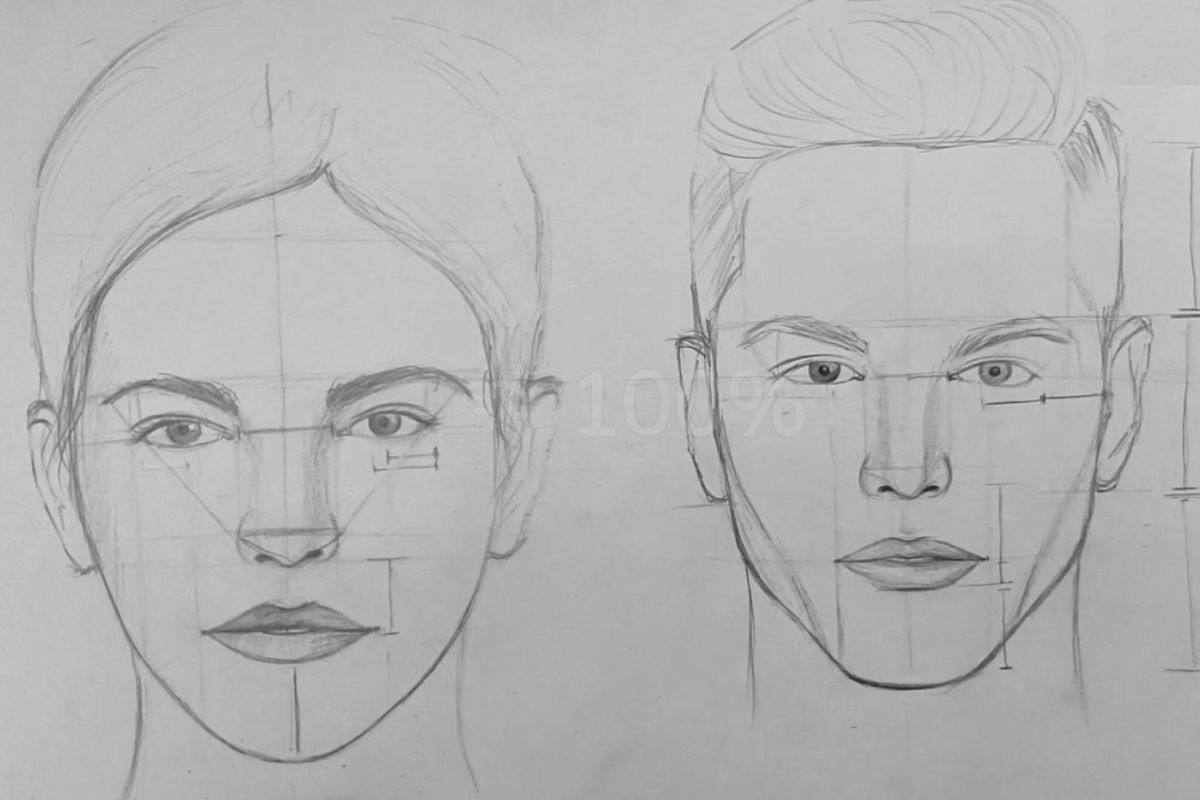
If you’re looking for a quick introduction to drawing faces that is easy and fun, look no further than this guide at VK Art Box. In just ten minutes, you can have your first official face drawing by following the step-by-step guide.
How to Draw a Realistic Face for Beginners
Drawing a realistic face can be a daunting goal for beginner artists, but there are a few tricks and hints you can use to make the process a little easier. Try these beginner hacks to make your first face drawings look more realistic:
- Break it down into small pieces. There’s no reason to focus on drawing an entire face from start to finish if you have no experience in drawing any of the individual features of the face since a mistake in any of them can make the whole face look unnatural. Instead, sketch pages of noses, mouths, lips, eyes, and proportional guidelines until you have a general idea about the anatomical structure behind the features of the face.
- Spend plenty of time on learning perspective and facial proportions. Mistakes in perspective and proportion are the top reason why many face drawings look “wrong” or unrealistic. Since the human brain is designed for scanning faces and facial expressions, any mistake in a face drawing will be very obvious to even a casual observer.
- Check out plenty of reference photos and illustrations. It’s a good idea to draw not only different types of faces, but also to do sketches of the underlying musculature and bone structure. This helps give you a better intrinsic knowledge of how to adjust facial features to represent the forms underneath.
How to Draw a Face FAQ
What Do You Start With When Drawing a Face?
When you first start drawing a face, the feature that you start with is two circles. These circles help set up the underlying structure of the skull and jaw, giving your face drawing realistic proportions.
You should also start by adding guidelines to the drawing to give you an indication of where the eyes, nose, and mouth will be located. Draw these lines as lightly as possible so they can be erased when the drawing is finalized.
What Is Drawing a Face Called?
Drawing a face is called either portraiture or caricature, depending on the context.
- Portraits are face drawings that can be either formal or informal but tend to follow realistic facial proportions.
- Caricatures often feature drawn faces that have had some facial features exaggerated to make the drawing more stylized or cartoonish.
Why Is Drawing a Face Hard?
Drawing a face is hard for several reasons. Here are a few of the chief reasons that artists find human portraits difficult compared to other types of drawings:
- Humans are good at recognizing inaccurate facial features
- Faces are assymmetrical
- Faces are proportional
- A knowledge of anatomy is essential
- Any inaccurate feature throws off the whole drawing
How to Draw a Face Conclusion
Learning how to draw a face can be one of the most challenging projects an artist takes on as they learn more complicated and advanced drawing techniques. However, the guide and projects above should give you a useful jumping-off point to mastering this skill for yourself.
